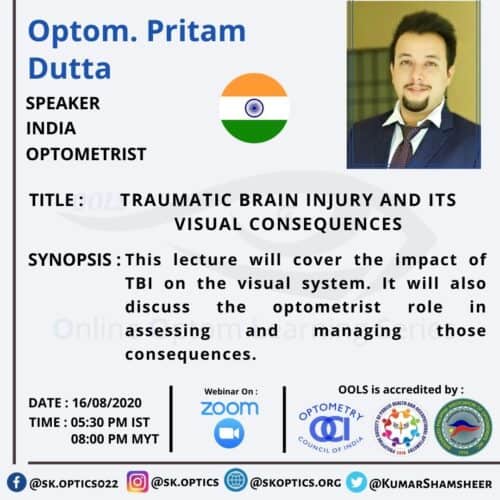
Mr. Pritam Dutta, a practicing optometrist, begins with an overview of the impact and prevalence of traumatic brain injury (TBI) across the world. There is a worldwide prevalence of 302 mild TBI cases per 100,000 cases, and these have significant ocular consequences. We learn that TBI is defined as ‘traumatically induced physiological disruption of brain function.
Pritam talks about the classification of mild, moderate, and severe TBI. He lists the common causes of mild TBI. It is important to understand brain anatomy and visual function neurons. Mr. Dutta explains how visual consequences in mild TBI occurs, and he enlists some of the commonly associated symptoms. The following are the three major impact areas of mild TBI:-
- Accommodation
- Vergence
- Eye movements
We then shift focus to understanding the role of oculomotor rehabilitation in cases of mild TBI. Pritam informs us how rehabilitation can be used to improve the accommodative and vergence functions. Apart from oculomotor vision problems, mild TBI also causes non-oculomotor-based vision problems. These may include:-
- Photosensitivity
- Vestibular dysfunction
- Abnormal spatial localization
- Visual field
Pritam summarizes the above vision problems and describing the treatment options for these non-oculomotor-based vision problems. We briefly go over the optometric work-up to follow in the case of a TBI patient. We also learn about some of the advanced diagnostic sensory testing’s in TBI. Lastly, this session is concluded with a short Q and A session with the live audience.
References
Websites
India TBI cases
http://indianheadinjuryfoundation.org/media-center/gallery/
Instrument – Visagraph
https://www.bernell.com/product/VISYSOD/1268
Editorials
Definition of TBI
ACRM A. Developed by the Mild Traumatic Brain Injury Committee of the Head Injury Interdisciplinary Special Interest Group of the American Congress of Rehabilitation Medicine.
https://www.acrm.org/wp-content/uploads/pdf/TBIDef_English_10-10.pdf
Classification of TBI
https://www.healthquality.va.gov/guidelines/Rehab/mtbi/concussion_mtbi_full_1_0.pdf
Conceptual model of optometric vision care in mild TBI
http://www.optometrystudents.com/wp-content/uploads/2011/12/4-Tier-Approach-in-mTBI.pdf
Papers
Prevalence
GBD 2016 Traumatic Brain Injury and Spinal Cord Injury Collaborators. Global, regional, and national burden of traumatic brain injury and spinal cord injury, 1990-2016: a systematic analysis for the Global Burden of Disease Study 2016. Lancet Neurol. 2019;18(1):56-87.
https://pubmed.ncbi.nlm.nih.gov/30497965/
Skandsen T, Nilsen TL, Einarsen C, et al. Incidence of Mild Traumatic Brain Injury: A Prospective Hospital, Emergency Room and General Practitioner-Based Study. Front Neurol. 2019;10:638. Published 2019 Jun 18.
https://pubmed.ncbi.nlm.nih.gov/31275229/
Ciuffreda KJ, Ludlam DP, Kapoor N. Clinical oculomotor training in traumatic brain injury. Optom Vis Dev 2009;40(1):16-23.
Accommodation in m-TBI
Duane A. Studies in Monocular and Binocular Accommodation, with Their Clinical Application. Trans Am Ophthalmol Soc. 1922;20:132-157.
https://pubmed.ncbi.nlm.nih.gov/16692582/
Suchoff IB, Kapoor N, Waxman R, Ference W. The occurrence of ocular and visual dysfunctions in an acquired brain-injured patient sample. J Am Optom Assoc. 1999;70(5):301-308.
https://pubmed.ncbi.nlm.nih.gov/10457707/
Ciuffreda KJ, Kapoor N, Rutner D, Suchoff IB, Han ME, Craig S. Occurrence of oculomotor dysfunctions in acquired brain injury: a retrospective analysis. Optometry. 2007;78(4):155-161.
https://pubmed.ncbi.nlm.nih.gov/17400136/
Kowal L. Ophthalmic manifestations of head injury. Aust N Z J Ophthalmol. 1992;20(1):35-40.
https://pubmed.ncbi.nlm.nih.gov/1599665/
Vergence in m-TBI
Thiagarajan P, Ciuffreda KJ, Ludlam DP. Vergence dysfunction in mild traumatic brain injury (mTBI): a review. Ophthalmic Physiol Opt. 2011;31(5):456-468.
https://pubmed.ncbi.nlm.nih.gov/21410499/
Eye movements in m-TBI
Reddy AVC, Mani R, Selvakumar A, Hussaindeen JR. Reading eye movements in traumatic brain injury. J Optom. 2020;13(3):155-162.
https://pubmed.ncbi.nlm.nih.gov/31784207/
Mani R, Asper L, Khuu SK. Deficits in saccades and smooth-pursuit eye movements in adults with traumatic brain injury: a systematic review and meta-analysis. Brain Inj. 2018;32(11):1315-1336.
https://pubmed.ncbi.nlm.nih.gov/29913089/
Oculomotor Rehabilitation
Thiagarajan P, Ciuffreda KJ. Effect of oculomotor rehabilitation on vergence responsivity in mild traumatic brain injury. J Rehabil Res Dev. 2013;50(9):1223-1240.
https://pubmed.ncbi.nlm.nih.gov/24458963/
Thiagarajan P, Ciuffreda KJ. Effect of oculomotor rehabilitation on accommodative responsivity in mild traumatic brain injury. J Rehabil Res Dev. 2014;51(2):175-191.
https://pubmed.ncbi.nlm.nih.gov/24933717/
Thiagarajan P, Ciuffreda KJ, Capo-Aponte JE, Ludlam DP, Kapoor N. Oculomotor neurorehabilitation for reading in mild traumatic brain injury (mTBI): an integrative approach. NeuroRehabilitation. 2014;34(1):129-146.
https://pubmed.ncbi.nlm.nih.gov/24284470/
Non-oculomotor rehabilitation
Capó-Aponte JE, Urosevich TG, Temme LA, Tarbett AK, Sanghera NK. Visual dysfunctions and symptoms during the subacute stage of blast-induced mild traumatic brain injury. Mil Med. 2012;177(7):804-813.
https://pubmed.ncbi.nlm.nih.gov/22808887/
Truong JQ, Ciuffreda KJ. Objective Pupillary Correlates of Photosensitivity in the Normal and Mild Traumatic Brain Injury Populations. Mil Med. 2016;181(10):1382-1390.
https://pubmed.ncbi.nlm.nih.gov/27753579/
Akin FW, Murnane OD, Hall CD, Riska KM. Vestibular consequences of mild traumatic brain injury and blast exposure: a review. Brain Inj. 2017;31(9):1188-1194.
https://pubmed.ncbi.nlm.nih.gov/28981340/
Suchoff IB, Kapoor N, Ciuffreda KJ, Rutner D, Han E, Craig S. The frequency of occurrence, types, and characteristics of visual field defects in acquired brain injury: a retrospective analysis. Optometry. 2008;79(5):259-265.
https://pubmed.ncbi.nlm.nih.gov/18436166/
Walsh DV, Capó-Aponte JE, Jorgensen-Wagers K, et al. Visual field dysfunctions in warfighters during different stages following blast and nonblast mTBI. Mil Med. 2015;180(2):178-185.
https://pubmed.ncbi.nlm.nih.gov/25643385/
Surveys
Dizziness Handicap Inventory
http://www.rehab.msu.edu/_files/_docs/Dizziness_Handicap_Inventory.pdf
Activity specific balance confidence scale
https://www.healyphysicaltherapy.com/pdfs/abc-scale.pdf
Visual vertigo analogue scale
https://www.neuropt.org/docs/vestibular-sig/visual-vertigo-analog-scale.pdf?sfvrsn=ce1735a5_4
